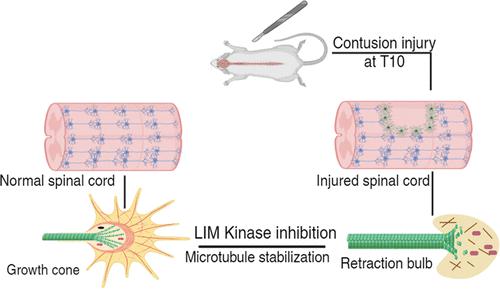当前位置:
X-MOL 学术
›
ACS Pharmacol. Transl. Sci.
›
论文详情
Our official English website, www.x-mol.net, welcomes your feedback! (Note: you will need to create a separate account there.)
Investigating LIM (Lin-11, Isl-1, and Mec-3) Kinases and Their Correlation with Pathological Events and Microtubule Dynamics in an Experimental Model of Spinal Cord Injury in Rats
ACS Pharmacology & Translational Science Pub Date : 2024-02-07 , DOI: 10.1021/acsptsci.3c00272 Abhishek Roy 1 , Zarna Pathak 1 , Hemant Kumar 1
ACS Pharmacology & Translational Science Pub Date : 2024-02-07 , DOI: 10.1021/acsptsci.3c00272 Abhishek Roy 1 , Zarna Pathak 1 , Hemant Kumar 1
Affiliation

|
The spinal cord injury (SCI) and the neurodegenerative processes accompanying it follow an intricate pathway with very limited options for treatment strategies until now. Microtubules, essential for the growth and maintenance of neurons, are mostly disorganized and destabilized due to neurodegeneration. Regeneration or plasticity is restricted to the adult central nervous system (CNS) due to several intrinsic and extrinsic mechanisms. Some fundamental or injury-induced expressions of specific molecules can be inhibited or antagonized pharmacologically to protect neurons to a certain extent after neurodegeneration. Accordingly, these molecules offer an excellent target as a therapeutic approach to promote neuroprotection. LIM kinases (LIMKs) are one of these molecules that phosphorylates members of the actin-depolymerizing factor (ADF)/cofilin family of actin-binding and filament-severing proteins. The individual role of LIMKs has not yet been studied in the pathology of SCI. In this study, we targeted LIMK and checked its role in microtubule destabilization in vitro. LIMK1 was found to be upregulated after microtubule depolymerization and inhibition of LIMK with specific inhibitor-protected neurons. Then, we checked the expressions of individual LIMKs throughout different time points across SCI in a rat contusion model, correlating with established pathophysiological markers. The phosphorylated form of LIMK1 was found to be elevated at chronic time points after injury, where scar formation and diminution of neurons prevail. Finally, we targeted the LIMK pathway with its specific inhibitor BMS-5, which showed neuroprotection after SCI. Overall, our results provided a concept concerning how a small-molecule inhibitor of LIMK may offer a strategy to treat SCI-associated neurodegeneration.
中文翻译:

在大鼠脊髓损伤实验模型中研究 LIM(Lin-11、Isl-1 和 Mec-3)激酶及其与病理事件和微管动力学的相关性
脊髓损伤(SCI)和随之而来的神经退行性过程遵循一条复杂的途径,迄今为止治疗策略的选择非常有限。微管对于神经元的生长和维持至关重要,但由于神经变性,它们大多被破坏和不稳定。由于多种内在和外在机制,再生或可塑性仅限于成人中枢神经系统(CNS)。神经退行性变后,一些基础性或损伤诱导的特定分子的表达可以通过药理学抑制或拮抗,从而在一定程度上保护神经元。因此,这些分子提供了一个极好的靶标作为促进神经保护的治疗方法。LIM 激酶 (LIMK) 是磷酸化肌动蛋白结合和丝切断蛋白的肌动蛋白解聚因子 (ADF)/cofilin 家族成员的分子之一。LIMKs 在 SCI 病理学中的个体作用尚未得到研究。在这项研究中,我们以 LIMK 为靶点,并检查其在体外微管不稳定中的作用。发现微管解聚并用特定抑制剂保护的神经元抑制 LIMK 后,LIMK1 上调。然后,我们检查了大鼠挫伤模型中 SCI 不同时间点各个 LIMK 的表达,并与已建立的病理生理标志物相关。LIMK1 的磷酸化形式被发现在损伤后的慢性时间点升高,此时疤痕形成和神经元减少普遍存在。最后,我们用其特异性抑制剂 BMS-5 靶向 LIMK 通路,该抑制剂在 SCI 后显示出神经保护作用。总的来说,我们的结果提供了一个概念,即 LIMK 小分子抑制剂如何提供治疗 SCI 相关神经变性的策略。
更新日期:2024-02-07
中文翻译:

在大鼠脊髓损伤实验模型中研究 LIM(Lin-11、Isl-1 和 Mec-3)激酶及其与病理事件和微管动力学的相关性
脊髓损伤(SCI)和随之而来的神经退行性过程遵循一条复杂的途径,迄今为止治疗策略的选择非常有限。微管对于神经元的生长和维持至关重要,但由于神经变性,它们大多被破坏和不稳定。由于多种内在和外在机制,再生或可塑性仅限于成人中枢神经系统(CNS)。神经退行性变后,一些基础性或损伤诱导的特定分子的表达可以通过药理学抑制或拮抗,从而在一定程度上保护神经元。因此,这些分子提供了一个极好的靶标作为促进神经保护的治疗方法。LIM 激酶 (LIMK) 是磷酸化肌动蛋白结合和丝切断蛋白的肌动蛋白解聚因子 (ADF)/cofilin 家族成员的分子之一。LIMKs 在 SCI 病理学中的个体作用尚未得到研究。在这项研究中,我们以 LIMK 为靶点,并检查其在体外微管不稳定中的作用。发现微管解聚并用特定抑制剂保护的神经元抑制 LIMK 后,LIMK1 上调。然后,我们检查了大鼠挫伤模型中 SCI 不同时间点各个 LIMK 的表达,并与已建立的病理生理标志物相关。LIMK1 的磷酸化形式被发现在损伤后的慢性时间点升高,此时疤痕形成和神经元减少普遍存在。最后,我们用其特异性抑制剂 BMS-5 靶向 LIMK 通路,该抑制剂在 SCI 后显示出神经保护作用。总的来说,我们的结果提供了一个概念,即 LIMK 小分子抑制剂如何提供治疗 SCI 相关神经变性的策略。



























 京公网安备 11010802027423号
京公网安备 11010802027423号